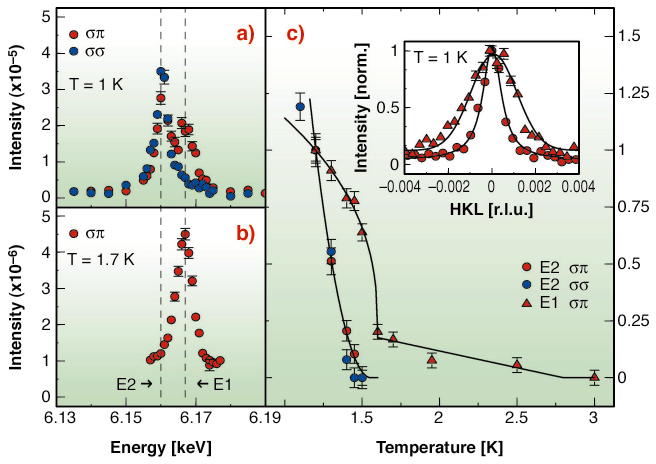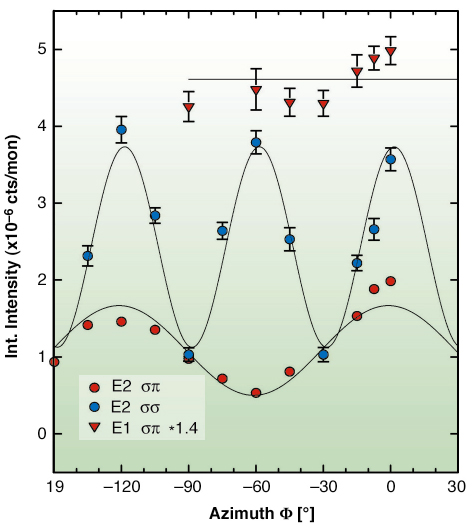- Home
- Users & Science
- Scientific Documentation
- ESRF Highlights
- ESRF Highlights 2005
- X-ray Absorption and Magnetic Scattering
- Unravelling Multipole Order with Resonant X-ray Scattering
Unravelling Multipole Order with Resonant X-ray Scattering
Neutron and X-ray scattering techniques are established microscopic tools to reveal magnetic structure. However, the familiar dipole magnetic order of ferromagnets and antiferromagnets is not the only possible order parameter. Higher order geometric constructs, generically known as multipoles, may become the primary order parameter in some instances. A powerful new microscope of both magnetic and multipole order is provided by resonant X-ray scattering (RXS).
We have used RXS to elucidate the hitherto incomprehensible long range order occurring in phase IV of Ce0.7La0.3B6, which condenses out of the paramagnetic phase below TIV = 1.5 K. The results indicate that below TIV a novel state of electronic order parameter segregation exists in which the polarisation of the 4f states exhibits octupole multipole order symmetry coexisting with dipole magnetic order of the 5d levels [1]. The success of the experiments have hinged crucially on development of a compact 1.0 Kelvin base temperature cryostat at the XMaS beamline of the ESRF [2].
Figure 107a gives the low temperature (1K) RXS polarised peak intensity, as a function of the incident photon energy at the Ce L2 edge of the (3/2 3/2 3/2) position. The ![]()
![]() (open circles) response, wherein the outgoing photon experiences a
(open circles) response, wherein the outgoing photon experiences a ![]() /2 rotation of its electric field, is characterised by two peaks. The upper coincides with the white-line of the absorption edge (E = 6.167 keV) and is assigned to electric dipole transitions (E1) probing the 5d conduction states, while the lower, at 6.160 keV, is associated with electric quadrupole (E2) transitions probing the 4f states. For the ss intensities (solid circles, no change in polarisation), only the E2 RXS peak is present. The lack of an E1
/2 rotation of its electric field, is characterised by two peaks. The upper coincides with the white-line of the absorption edge (E = 6.167 keV) and is assigned to electric dipole transitions (E1) probing the 5d conduction states, while the lower, at 6.160 keV, is associated with electric quadrupole (E2) transitions probing the 4f states. For the ss intensities (solid circles, no change in polarisation), only the E2 RXS peak is present. The lack of an E1 ![]()
![]() component, explored over a broad range of azimuth settings, provides clear evidence of magnetic dipole order in the 5d shell.
component, explored over a broad range of azimuth settings, provides clear evidence of magnetic dipole order in the 5d shell.
A dramatic difference is observed in the temperature dependence of the polarised scattered intensities at the E1 and E2 energy thresholds, as demonstrated in Figure 107c. The E2 ![]()
![]() and
and ![]()
![]() intensities decrease at the same rapid rate above 1K and disappear at TIV = 1.5 K. However, the E1
intensities decrease at the same rapid rate above 1K and disappear at TIV = 1.5 K. However, the E1 ![]()
![]() intensity decreases only gradually with increasing temperature, suffers a discontinuity at TIV, and continues up to ~ 3 K, i.e. well into the nominal paramagnetic phase. The effect is highlighted by comparing the energy response of the
intensity decreases only gradually with increasing temperature, suffers a discontinuity at TIV, and continues up to ~ 3 K, i.e. well into the nominal paramagnetic phase. The effect is highlighted by comparing the energy response of the ![]()
![]() intensities below, Figure 107a, and above, Figure 107b, TIV where only the E1 RXS response remains. Below TIV the thermal evolution of underlying sub-lattice order parameters can be described by I = |T-TIV|2ß(5d,4f) where ß(5d,4f) are the power law exponents for the 5d and 4f responses. The solid lines for T < TIV in the temperature dependence of Figure 107c are fits with ß(5d) = 0.33, ß(4f) = 0.99 and TIV = 1.5 K. The ratio of ß coefficients is compatible with 5d magnetic and 4f octupole order.
intensities below, Figure 107a, and above, Figure 107b, TIV where only the E1 RXS response remains. Below TIV the thermal evolution of underlying sub-lattice order parameters can be described by I = |T-TIV|2ß(5d,4f) where ß(5d,4f) are the power law exponents for the 5d and 4f responses. The solid lines for T < TIV in the temperature dependence of Figure 107c are fits with ß(5d) = 0.33, ß(4f) = 0.99 and TIV = 1.5 K. The ratio of ß coefficients is compatible with 5d magnetic and 4f octupole order.
 |
|
Fig. 107: (a) & (b) The RXS for the (blue circles) |
The widths of the longitudinal scans taken at E1 and E2, given in insert of Figure 107c, are also markedly different. The E2 data is consistent with long-range order, while the E1 data is broad, indicating a mesoscopic order ~ 20-30 nm. The E1 intensity above TIV, taken in conjunction with the radically different widths in the longitudinal scans, gives clear evidence for electronic order parameter segregation at a mesoscopic level in this compound.
The azimuth dependence of the (3/2 3/2 3/2) Bragg reflections for the E1 [![]()
![]() (open triangles)] and E2 [
(open triangles)] and E2 [![]()
![]() (solid circles) and
(solid circles) and ![]()
![]() (open circles)] resonances at 1 K are shown in Figure 108. The inferences drawn confirm and extend those made on the basis of Figure 107. Namely, the E1
(open circles)] resonances at 1 K are shown in Figure 108. The inferences drawn confirm and extend those made on the basis of Figure 107. Namely, the E1 ![]()
![]() scattered beam is without azimuth dependence indicating 5d magnetic order, whilst the E2
scattered beam is without azimuth dependence indicating 5d magnetic order, whilst the E2 ![]()
![]() and
and ![]()
![]() dependencies arise from a scattering amplitude of octupole symmetry. In particular, at the E2 resonance, both
dependencies arise from a scattering amplitude of octupole symmetry. In particular, at the E2 resonance, both ![]()
![]() and
and ![]()
![]() scattering is observed with, however, different azimuth dependencies. The E2
scattering is observed with, however, different azimuth dependencies. The E2 ![]()
![]() scattering has six-fold symmetry, while the E2
scattering has six-fold symmetry, while the E2 ![]()
![]() is three-fold. The solid lines are fits which represent scattering amplitudes of octupole symmetry from the Ce 4f states. The model reproduces the azimuth dependencies together with their phase offset and relative intensities using only one scaling parameter [1].
is three-fold. The solid lines are fits which represent scattering amplitudes of octupole symmetry from the Ce 4f states. The model reproduces the azimuth dependencies together with their phase offset and relative intensities using only one scaling parameter [1].
 |
|
Fig. 108: The Azimuthal dependence of the RXS at the E1 and E2 energy thresholds for |
The symmetry analysis of the E2 azimuth, Bragg angle and temperature dependencies determined by the RXS technique, brings to light electronic order of octupole symmetry in Ce0.7La0.3B6. This polarisation, which exists uniquely below TIV (Figure 107), appears to characterise the enigmatic phase IV. The long-range octupole order occurs in the presence of a pre-existing short-range order of magnetic dipole symmetry. The different thermal and spatial RXS responses from the 4f and 5d states, provide unique evidence for a novel phase of valence band order-parameter segregation in Phase IV.
References
[1] D. Mannix, Y. Tanaka, D. Carbone, N. Bernhoeft and S. Kunii, Physical Review Letters 97, 117206 (2005).
[2] D. Mannix, P. Thompson, S. Brown, L. Bouchenoire and P. Canfield, Physica B 353, 121 (2004).
Authors
D. Mannix (a), Y. Tanaka (b), D. Carbone (c), N. Bernhoeft (d) and S. Kunii (e).
(a) XMaS Beamline, ESRF
(b) RIKEN Harima Institute, SPRING-8 (Japan)
(c) ESRF
(d) CEA-Granoble (France)
(e) Tohoku University, Sendai (Japan)



